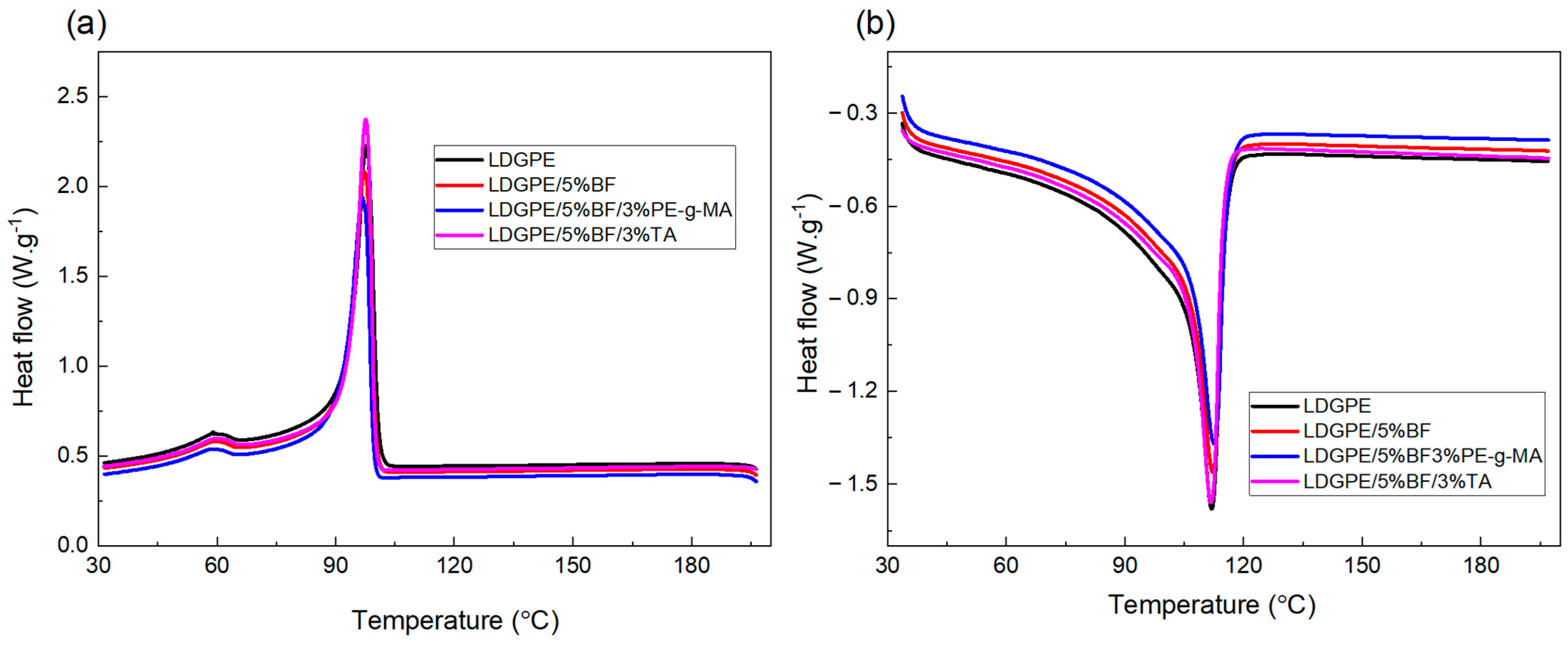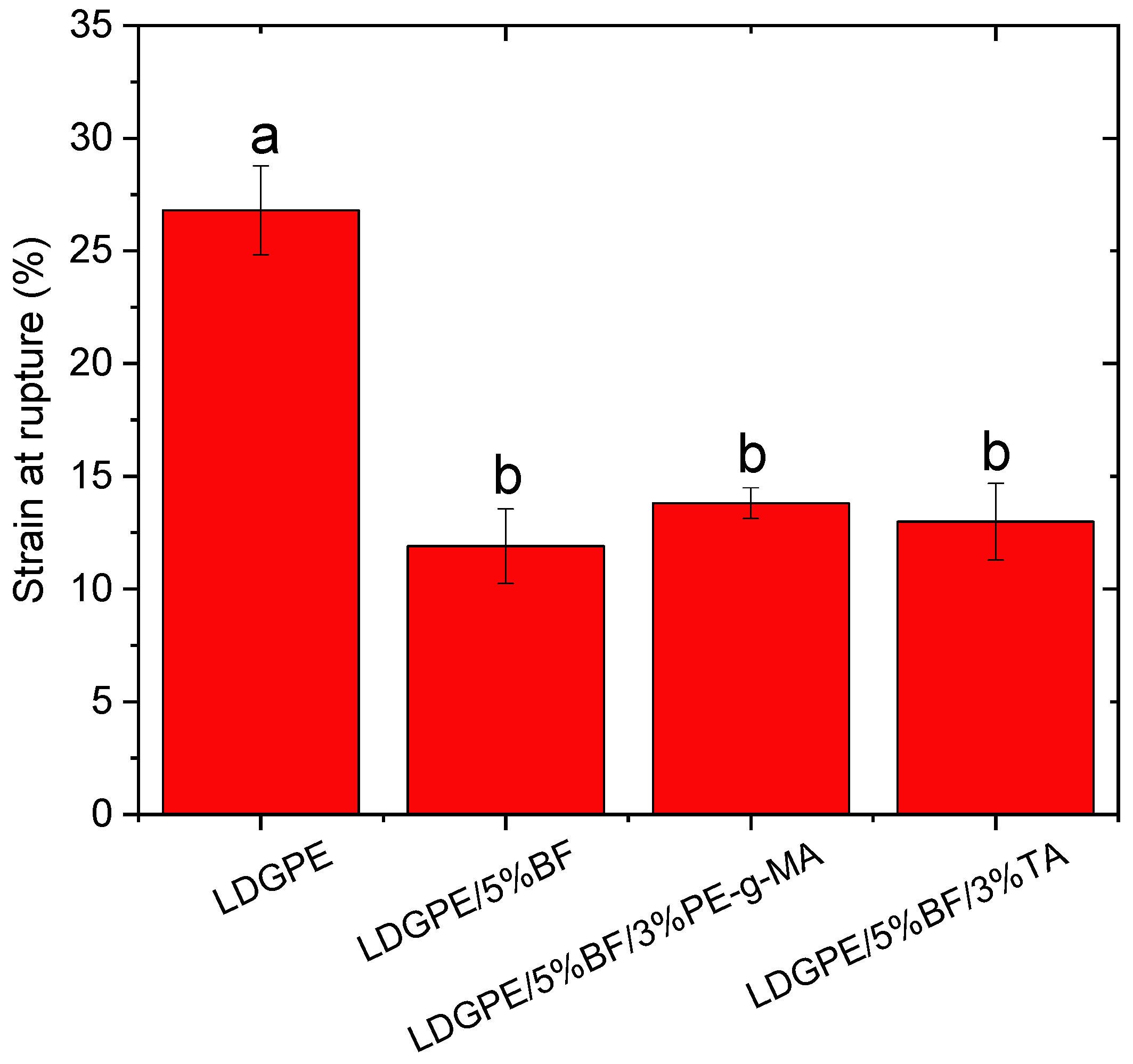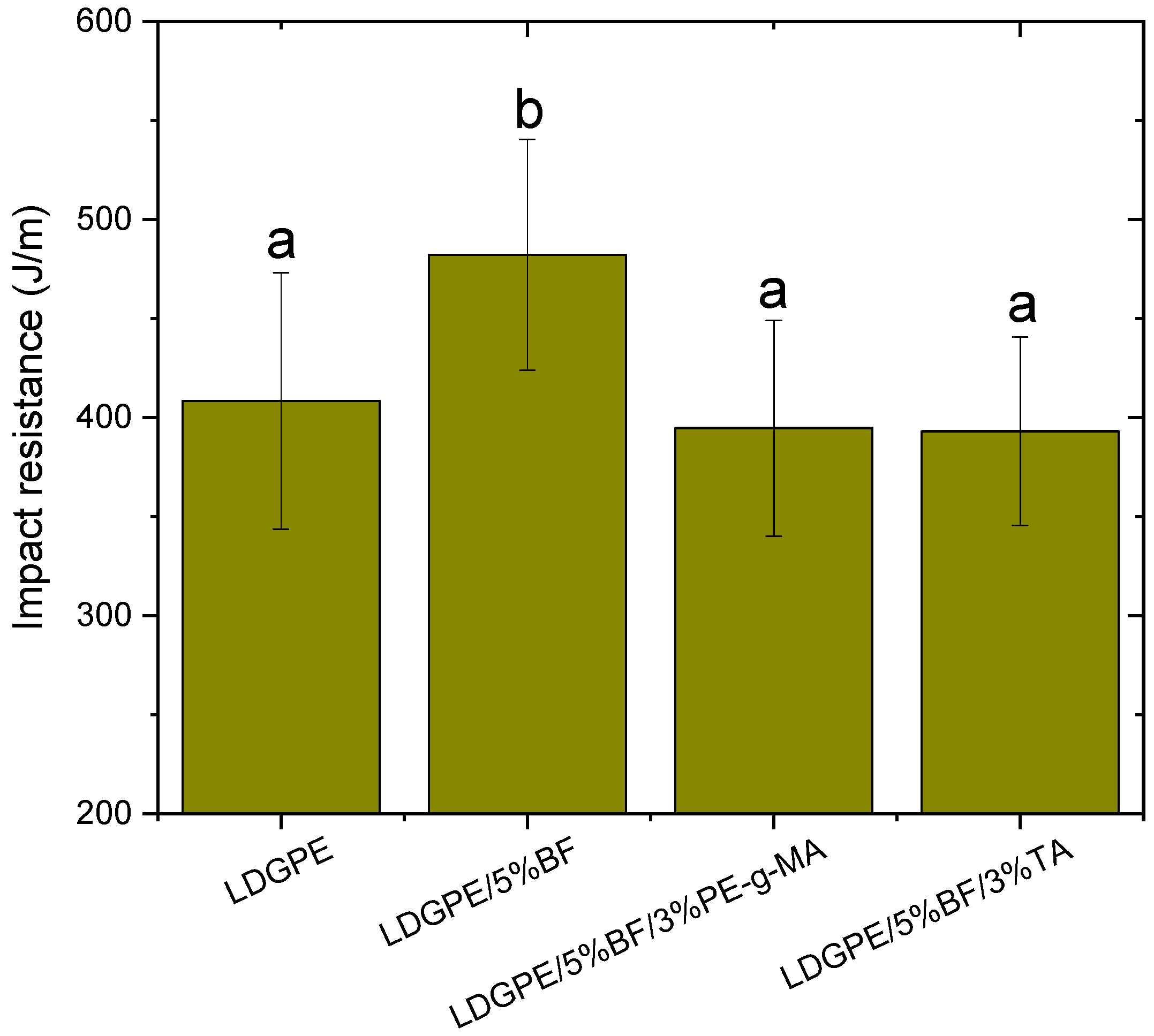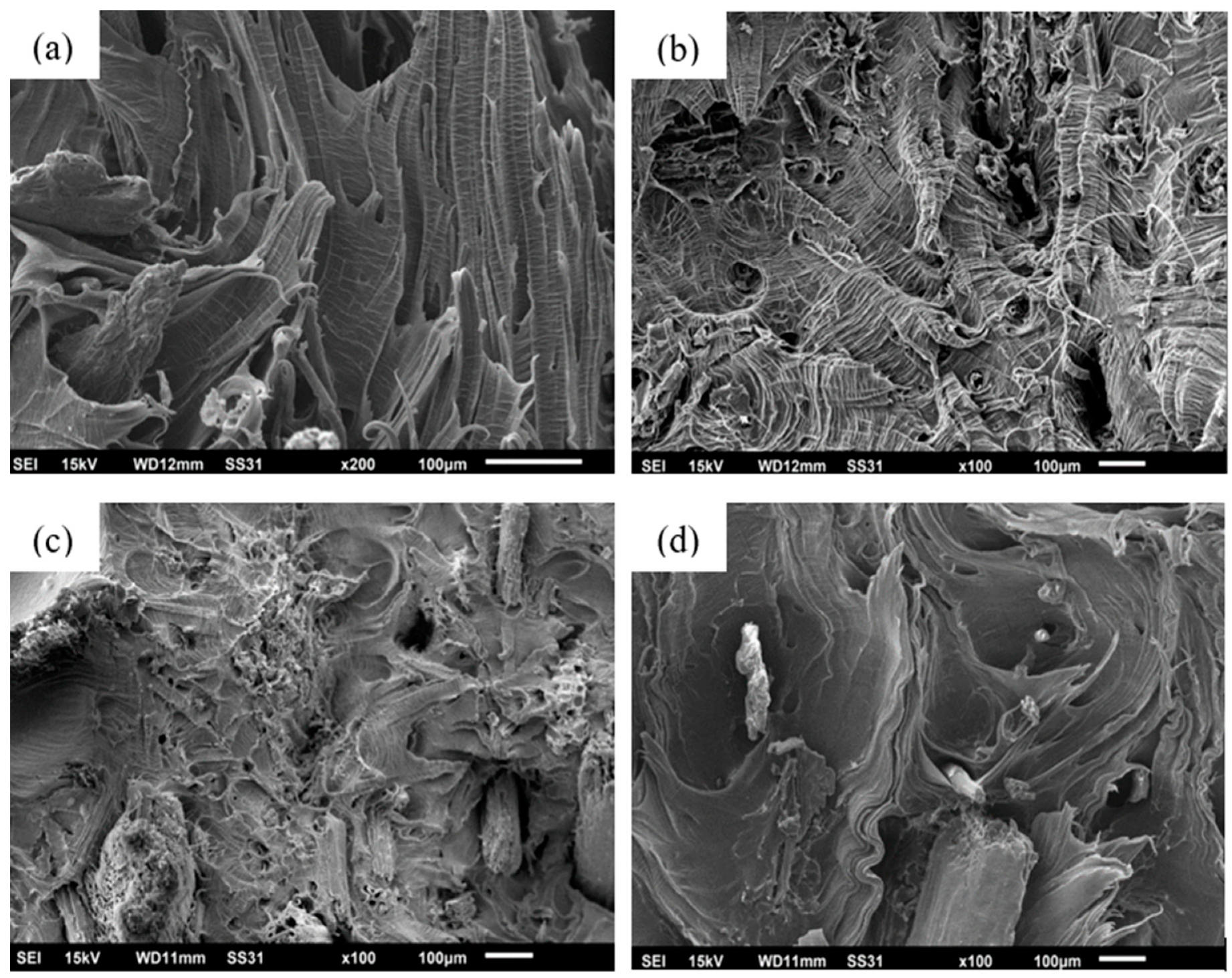Effect of Different Compatibilizers on the Properties of Green Low-Density Polyethylene Composites Reinforced with Bambusa Vulgaris Bamboo Fibers
Abstract
1. Introduction
2. Materials and Methods
2.1. Materials
2.2. Processing of the Composites
2.2.1. Extrusion Compounding
2.2.2. Injection Molding
2.3. Characterization of the Composites
2.3.1. Differential Scanning Calorimetry (DSC)
2.3.2. Uniaxial Tensile Test
2.3.3. Izod Impact Strength Test
2.3.4. Scanning Electron Microscopy (SEM)
3. Results
3.1. Characterization of the Composites
3.1.1. Differential Scanning Calorimetry (DSC)
3.1.2. Uniaxial Tensile Tests
3.1.3. Izod-Type Impact Strength Test
3.1.4. Scanning Electron Microscopy (SEM)
4. Conclusions
Author Contributions
Funding
Institutional Review Board Statement
Data Availability Statement
Conflicts of Interest
References
- Landim, A.P.M.; Bernardo, C.O.; Martins, I.B.A.; Francisco, M.R.; Santos, M.B.; Melo, N.R. de Sustainability Concerning Food Packaging in Brazil. Polímeros 2016, 26, 82–92. [Google Scholar] [CrossRef]
- Karthi, N.; Kumaresan, K.; Sathish, S.; Gokulkumar, S.; Prabhu, L.; Vigneshkumar, N. An Overview: Natural Fiber Reinforced Hybrid Composites, Chemical Treatments and Application Areas. Mater. Today Proc. 2020, 27, 2828–2834. [Google Scholar] [CrossRef]
- Rajak, D.; Pagar, D.; Menezes, P.; Linul, E. Fiber-Reinforced Polymer Composites: Manufacturing, Properties, and Applications. Polymers 2019, 11, 1667. [Google Scholar] [CrossRef] [PubMed]
- Conceição, I.D.d.; Silva, L.R.C.d.; Carvalho, L.H.d.; Costa, T.H.d.C.; Silva, H.d.S.e.; Alves, T.S.; Barbosa, R.; Sousa, R.R.M.d. Evaluation of the Effect of Plasma Treatment on the Surface of Green Polyethylene and Vermiculite Clay Films. Matéria 2019, 24, e12492. [Google Scholar] [CrossRef]
- Rosenboom, J.-G.; Langer, R.; Traverso, G. Bioplastics for a Circular Economy. Nat. Rev. Mater. 2022, 7, 117–137. [Google Scholar] [CrossRef] [PubMed]
- Brito, Y.C.; Medeiros, M.K.d.; Medeiros, M.K.d.; Sowek, A.B.; Sowek, A.B. Biodegradation in Simulated Soil of Green High Density Polyethylene with Soybean Meal. Braz. J. Dev. 2022, 8, 50458–50474. [Google Scholar] [CrossRef]
- Siracusa, V.; Blanco, I. Bio-Polyethylene (Bio-PE), Bio-Polypropylene (Bio-PP) and Bio-Poly(Ethylene Terephthalate) (Bio-PET): Recent Developments in Bio-Based Polymers Analogous to Petroleum-Derived Ones for Packaging and Engineering Applications. Polymers 2020, 12, 1641. [Google Scholar] [CrossRef] [PubMed]
- Dinesh; Kumar, B.; Kim, J. Mechanical and Dynamic Mechanical Behavior of the Lignocellulosic Pine Needle Fiber-Reinforced SEBS Composites. Polymers 2023, 15, 1225. [Google Scholar] [CrossRef] [PubMed]
- Ridho, M.R.; Agustiany, E.A.; Rahmi Dn, M.; Madyaratri, E.W.; Ghozali, M.; Restu, W.K.; Falah, F.; Rahandi Lubis, M.A.; Syamani, F.A.; Nurhamiyah, Y.; et al. Lignin as Green Filler in Polymer Composites: Development Methods, Characteristics, and Potential Applications. Adv. Mater. Sci. Eng. 2022, 2022, 1363481. [Google Scholar] [CrossRef]
- Moura, C.R. Aplicações e Tratamentos Da Fibra de Bambu e Similares: Uma Revisão. J. Eng. Exact Sci. 2019, 5, 0460–0468. [Google Scholar] [CrossRef]
- Nunes, G.D.M.; Sobrinho Júnior, A.D.S.; Pastor, J.D.S. O Uso Do Bambu Como Material Estrutural Na Construção Civil. Rev. Principia—Divulg. Cient. Tecnol. Do IFPB 2021, 1, 152. [Google Scholar] [CrossRef]
- Muhammad, A.; Rahman, M.R.; Hamdan, S.; Sanaullah, K. Recent Developments in Bamboo Fiber-Based Composites: A Review. Polym. Bull. 2019, 76, 2655–2682. [Google Scholar] [CrossRef]
- Lokesh, P.; Surya Kumari, T.S.A.; Gopi, R.; Babu Loganathan, G. A Study on Mechanical Properties of Bamboo Fiber Reinforced Polymer Composite. Mater. Today Proc. 2020, 22, 897–903. [Google Scholar] [CrossRef]
- Jagadeesh, P.; Puttegowda, M.; Mavinkere Rangappa, S.; Siengchin, S. A Review on Extraction, Chemical Treatment, Characterization of Natural Fibers and Its Composites for Potential Applications. Polym. Compos. 2021, 42, 6239–6264. [Google Scholar] [CrossRef]
- Yaragatti, N.; Patnaik, A. A Review on Additive Manufacturing of Polymers Composites. Mater. Today Proc. 2021, 44, 4150–4157. [Google Scholar] [CrossRef]
- Poletto, M. Thermoplastic Composites with Wood—A Brief Review. Rev. Interdiscip. Ciência Apl. 2017, 2, 42–48. [Google Scholar]
- Feng, Y.; Hao, H.; Lu, H.; Chow, C.L.; Lau, D. Exploring the Development and Applications of Sustainable Natural Fiber Composites: A Review from a Nanoscale Perspective. Compos. Part B Eng. 2024, 276, 111369. [Google Scholar] [CrossRef]
- Mengual, A.; Juárez, D.; Balart, R.; Ferrándiz, S. PE-g-MA, PP-g-MA and SEBS-g-MA Compatibilizers Used in Material Blends. Procedia Manuf. 2017, 13, 321–326. [Google Scholar] [CrossRef]
- Boopathi, S.; Sureshkumar, M.; Jeyakumar, M.; Kumar, R.S.; Subbiah, R. Influences of Fabrication Parameters on Natural Fiber Reinforced Polymer Composite (NFRPC) Material: A Review. Mater. Sci. Forum 2022, 1075, 115–124. [Google Scholar] [CrossRef]
- Luo, S.; Cao, J.; Sun, W. Evaluation of Kraft Lignin as Natural Compatibilizer in Wood Flour/Polypropylene Composites. Polym. Compos. 2017, 38, 2387–2394. [Google Scholar] [CrossRef]
- Yang, J.; Lu, S.; Luo, Q.; Song, L.; Li, Y.; Yu, J. Enhanced Mechanical and Thermal Properties of Polypropylene/Cellulose Fibers Composites with Modified Tannic as a Compatibilizer. Polym. Compos. 2018, 39, 2036–2045. [Google Scholar] [CrossRef]
- Liao, J.; Brosse, N.; Hoppe, S.; Du, G.; Zhou, X.; Pizzi, A. One-Step Compatibilization of Poly(Lactic Acid) and Tannin via Reactive Extrusion. Mater. Des. 2020, 191, 108603. [Google Scholar] [CrossRef]
- Aristri, M.A.; Lubis, M.A.R.; Laksana, R.P.B.; Sari, R.K.; Iswanto, A.H.; Kristak, L.; Antov, P.; Pizzi, A. Thermal and Mechanical Performance of Ramie Fibers Modified with Polyurethane Resins Derived from Acacia Mangium Bark Tannin. J. Mater. Res. Technol. 2022, 18, 2413–2427. [Google Scholar] [CrossRef]
- Pizzi, A. Tannins: Major Sources, Properties and Applications. In Monomers, Polymers and Composites from Renewable Resources; Elsevier: Amsterdam, The Netherlands, 2008; pp. 179–199. [Google Scholar]
- Missio, A.L.; Tischer, B.; dos Santos, P.S.B.; Codevilla, C.; de Menezes, C.R.; Barin, J.S.; Haselein, C.R.; Labidi, J.; Gatto, D.A.; Petutschnigg, A.; et al. Analytical Characterization of Purified Mimosa (Acacia Mearnsii) Industrial Tannin Extract: Single and Sequential Fractionation. Sep. Purif. Technol. 2017, 186, 218–225. [Google Scholar] [CrossRef]
- Abhilash, S.S.; Singaravelu, D.L. Effect of Fiber Content on Mechanical and Morphological Properties of Bamboo Fiber-Reinforced Linear Low-Density Polyethylene Processed by Rotational Molding. Trans. Indian Inst. Met. 2020, 73, 1549–1554. [Google Scholar] [CrossRef]
- Arman Alim, A.A.; Baharum, A.; Mohammad Shirajuddin, S.S.; Anuar, F.H. Blending of Low-Density Polyethylene and Poly(Butylene Succinate) (LDPE/PBS) with Polyethylene–Graft–Maleic Anhydride (PE–g–MA) as a Compatibilizer on the Phase Morphology, Mechanical and Thermal Properties. Polymers 2023, 15, 261. [Google Scholar] [CrossRef] [PubMed]
- ASTM D638; Standard Test Method for Tensile Properties of Plastics. ASTM: West Conshohocken, PA, USA, 2014; Volume 8, pp. 1–16.
- ASTM D256-10; Standard Test Methods for Determining the Izod Pendulum Impact Resistance of Plastics. ASTM: West Conshohocken, PA, USA, 2010; Volume 3, pp. 1–20. [CrossRef]
- Dolza, C.; Fages, E.; Gonga, E.; Gomez-Caturla, J.; Balart, R.; Quiles-Carrillo, L. Development and Characterization of Environmentally Friendly Wood Plastic Composites from Biobased Polyethylene and Short Natural Fibers Processed by Injection Moulding. Polymers 2021, 13, 1692. [Google Scholar] [CrossRef]
- Olesik, P.; Godzierz, M.; Kozioł, M. Preliminary Characterization of Novel LDPE-Based Wear-Resistant Composite Suitable for FDM 3D Printing. Materials 2019, 12, 2520. [Google Scholar] [CrossRef] [PubMed]
- Kim, H.; Panda, P.K.; Sadeghi, K.; Seo, J. Poly (Vinyl Alcohol)/Hydrothermally Treated Tannic Acid Composite Films as Sustainable Antioxidant and Barrier Packaging Materials. Prog. Org. Coatings 2023, 174, 107305. [Google Scholar] [CrossRef]
- Liao, J.; Brosse, N.; Pizzi, A.; Hoppe, S. Dynamically Cross-Linked Tannin as a Reinforcement of Polypropylene and UV Protection Properties. Polymers 2019, 11, 102. [Google Scholar] [CrossRef]
- Mostofi Sarkari, N.; Mohseni, M.; Ebrahimi, M. Examining Impact of Vapor-Induced Crosslinking Duration on Dynamic Mechanical and Static Mechanical Characteristics of Silane-Water Crosslinked Polyethylene Compound. Polym. Test. 2021, 93, 106933. [Google Scholar] [CrossRef]
- Liu, D.; Song, J.; Anderson, D.P.; Chang, P.R.; Hua, Y. Bamboo Fiber and Its Reinforced Composites: Structure and Properties. Cellulose 2012, 19, 1449–1480. [Google Scholar] [CrossRef]
- Anbupalani, M.S.; Venkatachalam, C.D.; Rathanasamy, R. Influence of Coupling Agent on Altering the Reinforcing Efficiency of Natural Fibre-Incorporated Polymers—A Review. J. Reinf. Plast. Compos. 2020, 39, 520–544. [Google Scholar] [CrossRef]
- Liao, J.; Brosse, N.; Pizzi, A.; Hoppe, S.; Xi, X.; Zhou, X. Polypropylene Blend with Polyphenols through Dynamic Vulcanization: Mechanical, Rheological, Crystalline, Thermal, and UV Protective Property. Polymers 2019, 11, 1108. [Google Scholar] [CrossRef] [PubMed]
- Daramola, O.O.; Akinwekomi, A.D.; Adediran, A.A.; Akindote-White, O.; Sadiku, E.R. Mechanical Performance and Water Uptake Behaviour of Treated Bamboo Fibre-Reinforced High-Density Polyethylene Composites. Heliyon 2019, 5, e02028. [Google Scholar] [CrossRef] [PubMed]
- NEGAWO, T.A.; Polat, Y.; Kilic, A. Effect of Compatibilizer and Fiber Loading on Ensete Fiber-Reinforced HDPE Green Composites: Physical, Mechanical, and Morphological Properties. Compos. Sci. Technol. 2021, 213, 108937. [Google Scholar] [CrossRef]
- Ismail, A.B.; Bakar, H.B.A.; Shafei, S.B. Comparison of LDPE/Corn Stalk with Eco Degradant and LDPE/Corn Stalk with MAPE: Influence of Coupling Agent and Compatibiliser on Mechanical Properties. Mater. Today Proc. 2020, 31, 360–365. [Google Scholar] [CrossRef]
- Salmah, H.; Azieyanti, A.N. Properties of Recycled Polyethylene/ Chitosan Composites: The Effect of Polyethylene-Graft-Maleic Anhydride. J. Reinf. Plast. Compos. 2011, 30, 195–202. [Google Scholar] [CrossRef]
- Roumeli, E.; Terzopoulou, Z.; Pavlidou, E.; Chrissafis, K.; Papadopoulou, E.; Athanasiadou, E.; Triantafyllidis, K.; Bikiaris, D.N. Effect of Maleic Anhydride on the Mechanical and Thermal Properties of Hemp/High-Density Polyethylene Green Composites. J. Therm. Anal. Calorim. 2015, 121, 93–105. [Google Scholar] [CrossRef]
- Ma, H.; Qin, W.; Guo, B.; Li, P. Effect of Plant Tannin and Glycerol on Thermoplastic Starch: Mechanical, Structural, Antimicrobial and Biodegradable Properties. Carbohydr. Polym. 2022, 295, 119869. [Google Scholar] [CrossRef]
- Missio, A.L.; Mattos, B.D.; de Cademartori, P.H.G.; Berger, C.; Magalhães, W.L.E.; Haselein, C.R.; Gatto, D.A.; Petutschnigg, A.; Tondi, G. Impact of Tannin as Sustainable Compatibilizer for Wood-polypropylene Composites. Polym. Compos. 2018, 39, 4275–4284. [Google Scholar] [CrossRef]
- Hu, L.; Vuillaume, P.Y. Reactive Compatibilization of Polymer Blends by Coupling Agents and Interchange Catalysts. In Compatibilization of Polymer Blends; Elsevier: Amsterdam, The Netherlands, 2020; pp. 205–248. [Google Scholar]
- Wei, S.; Wang, C.; Guo, C.; Zhu, Y.; Cao, X.; Kuang, Q.; He, G. Oxidization and Chain-Branching Reaction for Recycling HDPE and Mixed HDPE/PP with In-situ Compatibilization by Ozone-Induced Reactive Extrusion. ChemSusChem 2023, 17, e202301035. [Google Scholar] [CrossRef]
- Nanni, A.; Parisi, M.; Colonna, M.; Messori, M. Thermo-Mechanical and Morphological Properties of Polymer Composites Reinforced by Natural Fibers Derived from Wet Blue Leather Wastes: A Comparative Study. Polymers 2021, 13, 1837. [Google Scholar] [CrossRef]
- Ramires, E.C.; Frollini, E. Tannin–Phenolic Resins: Synthesis, Characterization, and Application as Matrix in Biobased Composites Reinforced with Sisal Fibers. Compos. Part B Eng. 2012, 43, 2851–2860. [Google Scholar] [CrossRef]
- Candido, V.S.; Silva, A.C.R.d.; Simonassi, N.T.; Luz, F.S.d.; Monteiro, S.N. Toughness of Polyester Matrix Composites Reinforced with Sugarcane Bagasse Fibers Evaluated by Charpy Impact Tests. J. Mater. Res. Technol. 2017, 6, 334–338. [Google Scholar] [CrossRef]
- Hu, F.; Li, L.; Wu, Z.; Yu, L.; Liu, B.; Cao, Y.; Xu, H. Surface Characteristics of Thermally Modified Bamboo Fibers and Its Utilization Potential for Bamboo Plastic Composites. Materials 2022, 15, 4481. [Google Scholar] [CrossRef]
- Wang, X.; Song, R.; Chen, Y.; Zhao, Y.; Zhu, K.; Yuan, X. Mechanical Properties of Polypropylene by Diversely Compatibilizing with Titanate Whiskers in Composites. Compos. Sci. Technol. 2018, 164, 103–109. [Google Scholar] [CrossRef]
- Jubinville, D.; Chang, B.P.; Pin, J.-M.; Mohanty, A.K.; Misra, M. Synergistic Thermo-Oxidative Maleation of PA11 as Compatibilization Strategy for PA6 and PBT Blend. Polymer 2019, 179, 121594. [Google Scholar] [CrossRef]
- Lai, S.; Yeh, F.; Wang, Y.; Chan, H.; Shen, H. Comparative Study of Maleated Polyolefins as Compatibilizers for Polyethylene/Wood Flour Composites. J. Appl. Polym. Sci. 2003, 87, 487–496. [Google Scholar] [CrossRef]
- Kazayawoko, M.; Balatinecz, J.J.; Matuana, L.M. Surface Modification and Adhesion Mechanisms in Woodfiber-Polypropylene Composites. J. Mater. Sci. 1999, 34, 6189–6199. [Google Scholar] [CrossRef]
- Chin, S.C.; Tee, K.F.; Tong, F.S.; Ong, H.R.; Gimbun, J. Thermal and Mechanical Properties of Bamboo Fiber Reinforced Composites. Mater. Today Commun. 2020, 23, 100876. [Google Scholar] [CrossRef]
- Salman, S.D.; Sharba, M.J.; Leman, Z.; Sultan, M.T.H.; Ishak, M.R.; Cardona, F. Physical, Mechanical, and Morphological Properties of Woven Kenaf/Polymer Composites Produced Using a Vacuum Infusion Technique. Int. J. Polym. Sci. 2015, 2015, 894565. [Google Scholar] [CrossRef]
- Tang, Q.; Wang, Y.; Ren, Y.; Zhang, W.; Guo, W. A Novel Strategy for the Extraction and Preparation of Bamboo Fiber-reinforced Polypropylene Composites. Polym. Compos. 2019, 40, 2178–2186. [Google Scholar] [CrossRef]
- Mazur, K.; Kuciel, S. Mechanical and Hydrothermal Aging Behaviour of Polyhydroxybutyrate-Co-Valerate (PHBV) Composites Reinforced by Natural Fibres. Molecules 2019, 24, 3538. [Google Scholar] [CrossRef]
- Anggono, J.; Farkas, Á.E.; Bartos, A.; Móczó, J.; Antoni; Purwaningsih, H.; Pukánszky, B. Deformation and Failure of Sugarcane Bagasse Reinforced PP. Eur. Polym. J. 2019, 112, 153–160. [Google Scholar] [CrossRef]
- Ferreira, F.; Pinheiro, I.; de Souza, S.; Mei, L.; Lona, L. Polymer Composites Reinforced with Natural Fibers and Nanocellulose in the Automotive Industry: A Short Review. J. Compos. Sci. 2019, 3, 51. [Google Scholar] [CrossRef]
- Agüero, Á.; Garcia-Sanoguera, D.; Lascano, D.; Rojas-Lema, S.; Ivorra-Martinez, J.; Fenollar, O.; Torres-Giner, S. Evaluation of Different Compatibilization Strategies to Improve the Performance of Injection-Molded Green Composite Pieces Made of Polylactide Reinforced with Short Flaxseed Fibers. Polymers 2020, 12, 821. [Google Scholar] [CrossRef]
- Zhao, X.; Li, R.K.Y.; Bai, S.-L. Mechanical Properties of Sisal Fiber Reinforced High Density Polyethylene Composites: Effect of Fiber Content, Interfacial Compatibilization, and Manufacturing Process. Compos. Part A Appl. Sci. Manuf. 2014, 65, 169–174. [Google Scholar] [CrossRef]





| Sample | Content (wt%) |
|---|---|
| LDGPE | 100 |
| LDGPE/5%BF | 95/5 |
| LDGPE/5%BF/3%PE-g-MA | 92/5/3 |
| LDGPE/5%BF/3%TA | 92/5/3 |
| Samples | Tc (°C) | ΔHc (J·g−1) | Tm (°C) | ΔHm (J·g−1) | Xc (%) |
|---|---|---|---|---|---|
| LDGPE | 97.7 | 63.4 | 111.9 | 69.4 | 23.7 |
| LDGPE/5%BF | 97.3 | 61.0 | 112.1 | 63.6 | 22.8 |
| LDGPE/5%BF/3%PE-g-MA | 96.8 | 59.3 | 112.5 | 63.4 | 22.7 |
| LDGPE/5%BF/3%TA | 97.6 | 62.9 | 111.7 | 62.8 | 22.5 |
| Samples | Impact Resistance (J/m) |
|---|---|
| LDGPE | 408.4 ± 64.7 |
| LDGPE/5%BF | 482.1 ± 58.2 |
| LDGPE/5%BF/3% PE-g-MA | 394.7 ± 54.4 |
| LDGPE/5%BF/3%TA | 393.1 ± 47.6 |
Disclaimer/Publisher’s Note: The statements, opinions and data contained in all publications are solely those of the individual author(s) and contributor(s) and not of MDPI and/or the editor(s). MDPI and/or the editor(s) disclaim responsibility for any injury to people or property resulting from any ideas, methods, instructions or products referred to in the content. |
© 2024 by the authors. Licensee MDPI, Basel, Switzerland. This article is an open access article distributed under the terms and conditions of the Creative Commons Attribution (CC BY) license (https://creativecommons.org/licenses/by/4.0/).
Share and Cite
Bosenbecker, M.W.; Silva, E.V.; Paganotto, G.F.d.R.; Zanon, T.T.M.; Langone, F.; Rodrigues, M.B.B.; Marini, J.; Labidi, J.; Missio, A.L.; de Oliveira, A.D. Effect of Different Compatibilizers on the Properties of Green Low-Density Polyethylene Composites Reinforced with Bambusa Vulgaris Bamboo Fibers. Polymers 2024, 16, 1760. https://doi.org/10.3390/polym16131760
Bosenbecker MW, Silva EV, Paganotto GFdR, Zanon TTM, Langone F, Rodrigues MBB, Marini J, Labidi J, Missio AL, de Oliveira AD. Effect of Different Compatibilizers on the Properties of Green Low-Density Polyethylene Composites Reinforced with Bambusa Vulgaris Bamboo Fibers. Polymers. 2024; 16(13):1760. https://doi.org/10.3390/polym16131760
Chicago/Turabian StyleBosenbecker, Mariane W., Eduarda Vieira Silva, Gian Francesco dos Reis Paganotto, Tiago Thomaz Migliati Zanon, Fernanda Langone, Marlon Bender Bueno Rodrigues, Juliano Marini, Jalel Labidi, André Luiz Missio, and Amanda Dantas de Oliveira. 2024. "Effect of Different Compatibilizers on the Properties of Green Low-Density Polyethylene Composites Reinforced with Bambusa Vulgaris Bamboo Fibers" Polymers 16, no. 13: 1760. https://doi.org/10.3390/polym16131760
APA StyleBosenbecker, M. W., Silva, E. V., Paganotto, G. F. d. R., Zanon, T. T. M., Langone, F., Rodrigues, M. B. B., Marini, J., Labidi, J., Missio, A. L., & de Oliveira, A. D. (2024). Effect of Different Compatibilizers on the Properties of Green Low-Density Polyethylene Composites Reinforced with Bambusa Vulgaris Bamboo Fibers. Polymers, 16(13), 1760. https://doi.org/10.3390/polym16131760











